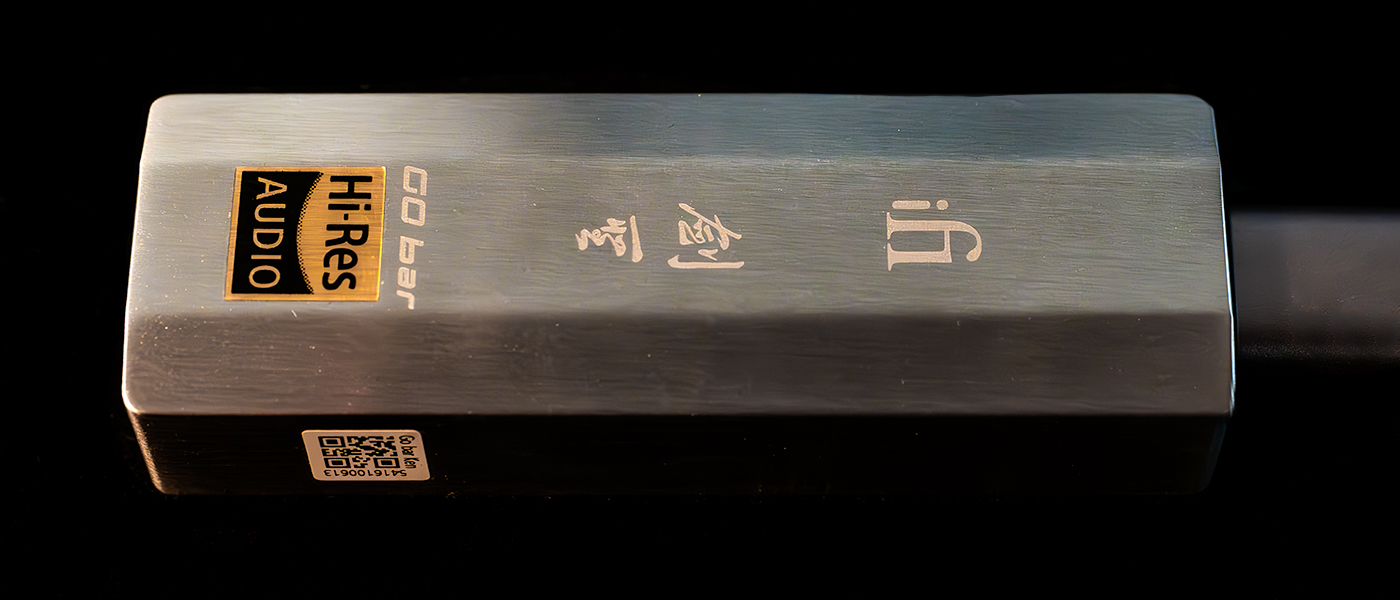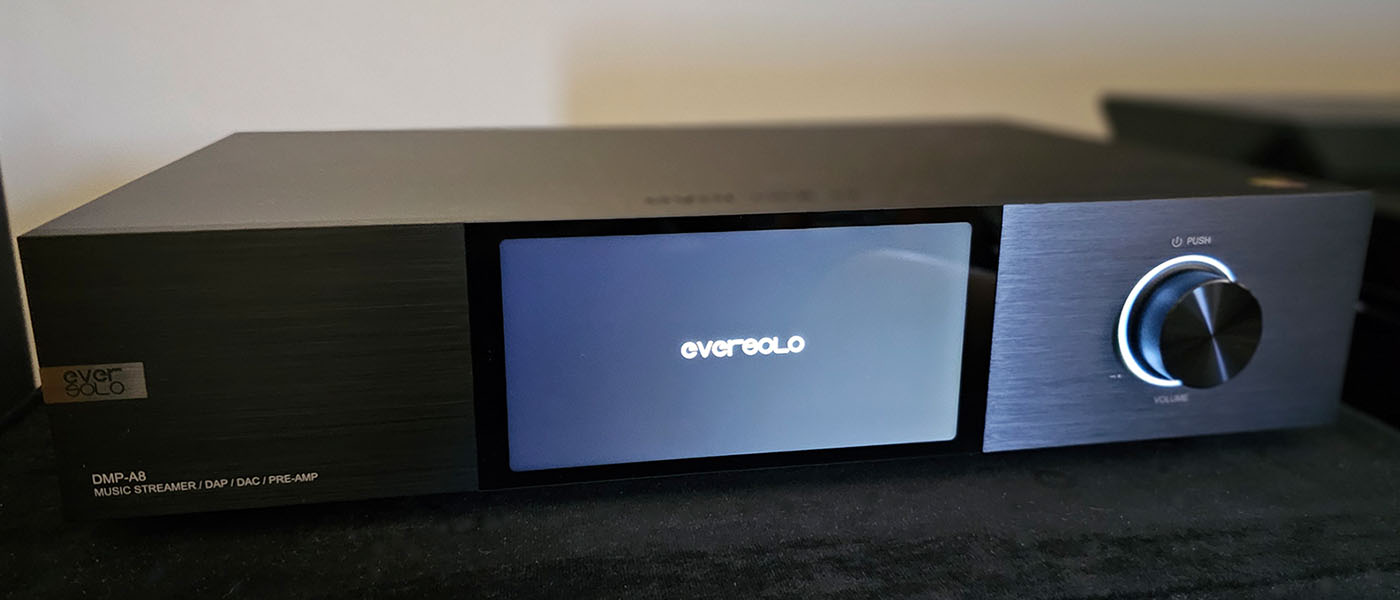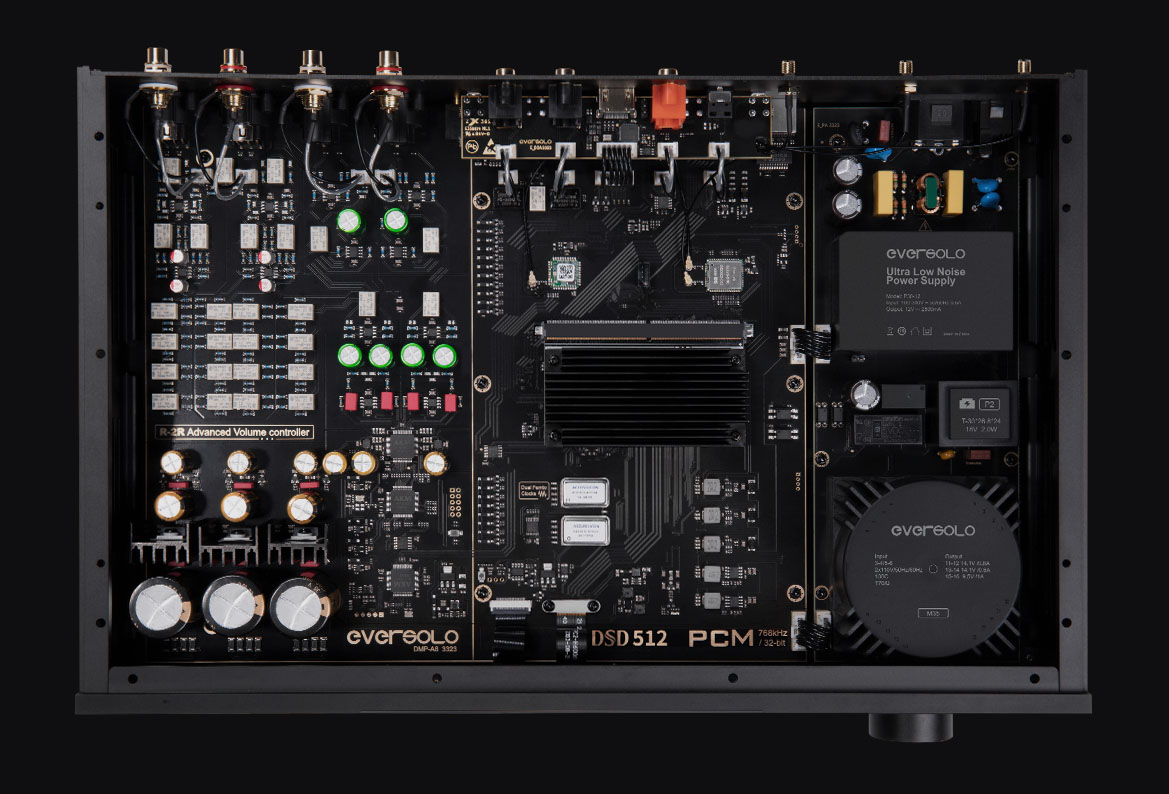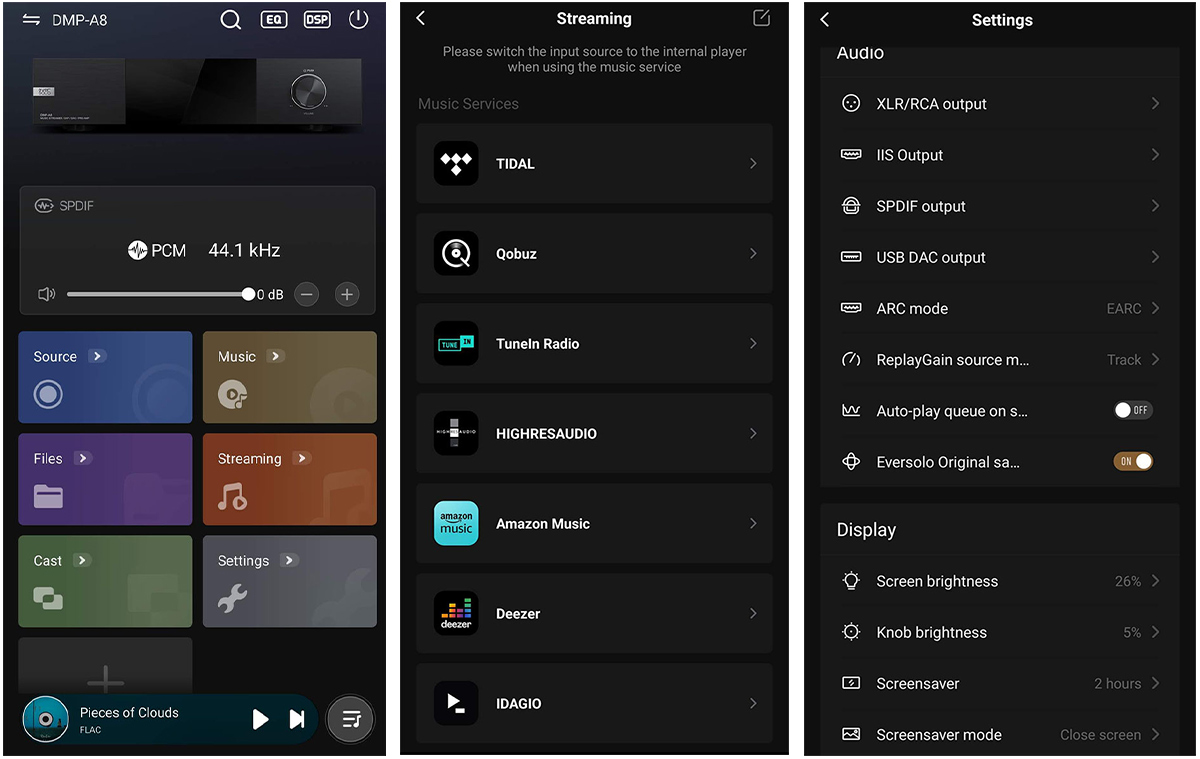The release of the DMP-A6 (MSRP $859), which is an incredibly affordable integrated streamer-DAC-preamplifier in 2023 has led to the exponential rise of popularity of the Eversolo brand. That product was very well received and highly regarded as a value champ. Later that year, Eversolo released the DMP-A8 (MSRP $1,980), which is the same type of product as the DMP-A6 but with improved hardware components and features. The DMP-A8 is the subject of this review.
Eversolo DMP-A8 Streamer-DAC-DAP-Preamplifier
- Simple yet appealing look with great build quality.
- 6′′ touchscreen color LCD front-panel display.
- Versatile digital and analog input and output connectivity.
- State-of-the-art DAC capable of decoding MQA signals and processing up to DSD512 Native and 32-bit/768 kHz PCM signals.
- Provision of storage expansion slot capable of accommodating up to 4 TB SSD.
- Bluetooth and Wi-Fi streaming feature.
- Eversolo app for streaming and device operational control.
Eversolo took the audio industry by storm with the release of its first multi-function streamer-DAC-preamplifier product, the DMP-A6, in May 2023. The reason for the popularity of the DMP- A6 is the value it brings. As a multi-function product, the DMP-A6 is quite inexpensive and it garners praise from audio reviewers and customers alike for its comprehensive feature set, backed up by respectable performance. The DMP-A6 definitely piqued my interest and curiosity as a reviewer, although I did not have a chance to jump onto the bandwagon as getting a review sample of this very popular product was a challenge.
About six months after the release of the DMP-A6, Eversolo added a new product to its streamer-DAC-preamplifier product lineup, the DMP-A8. The DMP-A8 costs more than double the cost of the DMP-A6 at $1,980, but it boasts significant internal upgrades. These upgrades include better-quality DACs, a dual femtosecond clock system, better op-amps, dual power supplies, and an R2R volume control circuit. The DMP-A8 piqued my interest even more as a reviewer, and I vowed to myself to make every effort possible to review it. However, even though more expensive, the DMP-A8 was not less popular than the DMP-A6, and getting a review sample was definitely not easy. The US distributor of Eversolo told me that they experienced a short supply of the product and had trouble filling backorders, hence allocating a product for review did not seem to be of interest. So, to get my hand on the product quicker, I decided to just put myself on the buyer waiting list and after a month or two of waiting, eventually my order got fulfilled.
The DMP-A8 indeed seems to be a lot of product for the money. Due to its multi-function nature, it can replace several stand-alone components in a system, and thus, it can simplify one’s system a great deal. In addition to the streamer, DAC, and preamplifier functions, the DMP-A8 can also serve as a Digital Audio Player (DAP) for the music stored in the SSD, which can be added internally to the unit, or any external storage connected through its USB OTG (On-The-Go) port. My report below will further look into the features that the unit is equipped with and the thing that matters the most, its audio performance.
Display:
6′′ LCD touchscreen
Internal Memory:
4GDDR4 + 64GeMMC
DAC:
AK4191EQ + AK4499EX
Audio Processor:
XMOS XU316
Op-amp:
ChipOPA1612
Power Supply:
High-quality, low-noise linear + digital dual power supply
SSD Support:
M.2 NVME3.0 2280 protocol, up to 4TB (SSD isn’t included)
USB-A Port:
2 x USB3.0
Ethernet:
RJ-45(10/100/1000Mbps)
WiFi:
WiFi 2.4G+5G dual-band
Playback and DAC Decoding:
Stereo DSD up to DSD512, stereo PCM up to 32-bit/768 kHz
Music Service Streaming:
Tidal, Qobuz, Highresaudio, Amazon Music, Deezer, Radio Paradise, WebDAV, UPnP, AirPlay, DLNA, Tidal Connect, etc.
Digital Audio Inputs:
Bluetooth: BT5.0, support SBC/AAC/aptX/aptX LL/aptX HD/LDAC
USB-B (1x): Supports Windows (10, 11), Android, iOS.
Support up to stereo DSD512 and PCM 32-bit/768 kHz
Optical/Coaxial (2x each): Support up to stereo PCM 24 bit/192 kHz, Dop64
HDMI ARC (1x): Support up to stereo PCM 24 bit/192 kHz
Analog Audio Inputs:
1 x XLR(Balanced) + 1 x RCA(Unbalanced), maximum gain +10 dB
Digital Audio Outputs:
USB-A (1x): Support up to stereo DSD512 and PCM 32-bit/768 kHz
IIS (1x): Support up to stereo DSD512 and PCM 32-bit/768 kHz
Optical/Coaxial (1x each): Support up to stereo PCM 24 bit/192 kHz, Dop64
Analog Audio Outputs:
1 x XLR(Balanced) + 1 x RCA (Unbalanced)
XLR Output Characteristics:
Output level: 4.2V
Frequency response: 20 Hz – 20 kHz (±0.25dB)
Dynamic range: > 128dB
SNR: >128dB
THD+N: <0.00009%(-120dB) @No-wt
Crosstalk: >-121dB
RCA Output Characteristics:
Output level: 2.1V
Frequency response: 20 Hz – 20kHz (±0.25dB)
Dynamic range: > 125dB
SNR: >125dB
THD+N: <0.00010%(-119dB) @A-WT
Crosstalk: >-121dB
Control Method:
Mobile App, touch-screen control, IR+Bluetooth remote control
PSU:
AC 110 – 240V, 50/60 Hz
Power Consumption:
16W
Dimensions (W x L x H):
15.3” x 9.8” x 3.5” (388mm x 248mm x 90mm)
Weight:
11 lbs. (5 kg)
Website:
Company:
MSRP:
$ 1,980.00
SECRETS Tags:
Eversolo, DMP-A8, Streamer, DAC, DAP, Preamplifier
Secrets Sponsor
The Eversolo DMP-A8 is slightly less wide than most standard audio components and sports a low profile (only 3.5” high). Its front panel looks modern and clean. Besides the Eversolo brand logo on the left side, the front panel is only occupied by a 6” high-definition touchscreen LCD in the middle and a push-type rotary knob on the right side (when viewed from the front). The DMP-A8 chassis is solidly constructed from CNC-machined aluminum. The combination of the brushed finish for the front panel and the frosted anodized finish for the rest of the body gives it an overall handsome appearance. Its weight is quite substantial for a unit of its size, which subtly suggests that this product is not to be taken lightly.
Indeed, what Eversolo puts into the DMP-A8 should not be taken lightly. Besides equipping it with comprehensive features, Eversolo seems to implement everything possible to get the best performance out of the DMP-A8. It uses a 3rd generation XMOS 316 (XU316) audio processor, which is state-of-the-art in terms of speed and bandwidth for audio applications. This processor can accommodate up to DSD512 Native and 32-bit/768-kHz PCM through USB ports and up to DSD64 (DOP) and 24-bit/192-kHz PCM through optical/coaxial ports. The DMP-A8 utilizes hybrid AKM DACs with separate Digital (AK4191EQ) and Analog (AK4499EX) processing sections to minimize the effects of digital noise on the analog outputs. Further enhancement in the digital audio decoding circuit includes dual femtoseconds high-precision clocks for better jitter suppression (45.1584MHz and 49.152MHz clocks, which correspond to the decoding of 44.1 kHz and 48 kHz multiplied sampling rates respectively). If you are a tweaker, you will be glad to know that the DMP-A8 is also equipped with Digital Signal Processing (DSP) functionality supporting features such as parametric equalization (PEQ), high-pass/low-pass filter, and loudness enhancement. The DSP feature only works with the internal player and digital inputs (coaxial/optical/USB-B/ARC) up to 192 kHz PCM signals, affecting the outputs through RCA/XLR analog audio ports. PCM and DSD signals above 192 kHz will only be passed through.
The DMP-A8 employs a dual power-supply design, separating the linear power supply for the audio circuit and the switching one for the rest of the system. Such a design is intended to keep the audio circuit free from possible interference and noise from the system’s circuit. Furthermore, the linear power supply voltage input incorporates a patented smart switching technology, which enables compatibility with voltages worldwide without the need to flip a switch. On the analog side, the DMP-A8 is equipped with a fully balanced preamplifier circuit. To achieve accurate volume control while keeping distortion and noise low, an R2R volume control module consisting of a network of resistors and relays is utilized. Because of the switching of the relays, such a design makes a clicking sound when the volume level is changed. More on this later.
The versatility of the DMP-A8 can be immediately inferred by its extensive input-output connectors, which are nicely arranged and grouped on the rear panel of the unit. The digital input connections include a USB, two coaxial, two optical, and a HDMI ARC. The analog input connections include a set of balanced (XLR) and a set of unbalanced (RCA) connectors. Similarly for the analog output connections. The variety of digital output connections provided in the DMP-A8 is commendable, which includes a USB, a coaxial, an optical, and an I2S connector. A wired Ethernet LAN connection is also available. Three antenna screw-in plugs are located on the rear panel to enhance its wireless (Wi-Fi and Bluetooth) connectivity. Three small antennas to be attached to these plugs are also provided. The DMP-A8 supports Bluetooth 5.0 with aptX-HD and dual-band Wi-Fi 2.4G/5G wireless connections. A DC trigger out, a USB Media connector, the power switch, and the power receptacle complete the extensive rear panel connectivity of the DMP-A8.
As a music streamer, the DMP-A8 is a versatile device. Not only does it support Roon Ready and other streaming protocols such as Tidal Connect and DLNA, but its internal player also incorporates popular streaming services such as Qobuz, Tidal, Deezer, Amazon Music, etc. Its versatility does not stop here. It has a slot to accommodate the installation of an SSD (up to 4 TB capacity) to store your music files internally. This slot is strategically located on the bottom panel, allowing SSD installation without opening the top cover of the device. Alternatively, one can also access music files stored on a connected USB stick or external USB drive. With an SSD installed or an external USB drive connected, the DMP-A8 can serve as a local network music server, which can be accessed by other devices on the same network under commonly used protocols, such as UPnP, NFS, and SMB v1/v2/v3.
Controlling the operation of the DMP-A8 can be done in various ways. Direct control of the unit can be done by the combination of the rotary knob and the 6” touchscreen display. A brief press on the rotary knob will turn the device on/off while rotating it will control the playback volume level. All the other controls, such as input selection and change of settings can be done through the touchscreen display. I found that the touch sensitivity of the display was sufficient and the Eversolo menu system was quite intuitive. Besides displaying the playback information, the display can be customized to simulate some variations of dynamic VU meters or spectrum visualizers. Even though it was gimmicky, I thought it was a nice use of the display to give the device some optional skin appearance.
A small remote control with dual-mode support for infrared and Bluetooth is supplied with the DMP-A8. Even though the remote has a plastic enclosure, it feels quite sturdy and has nicely laid-out and good-sized buttons. It is not backlit, but I think this is not a drawback in this case as the unit can be operated using the app, which can be a more convenient alternative to use in a dark environment. This remote control provides the convenience of quick powering on/stand by the device and controlling its playback operation from the convenience of your seat. If the device is not connected to the network using a wired LAN, then the remote powering on the device can only be done using the power button on the remote.
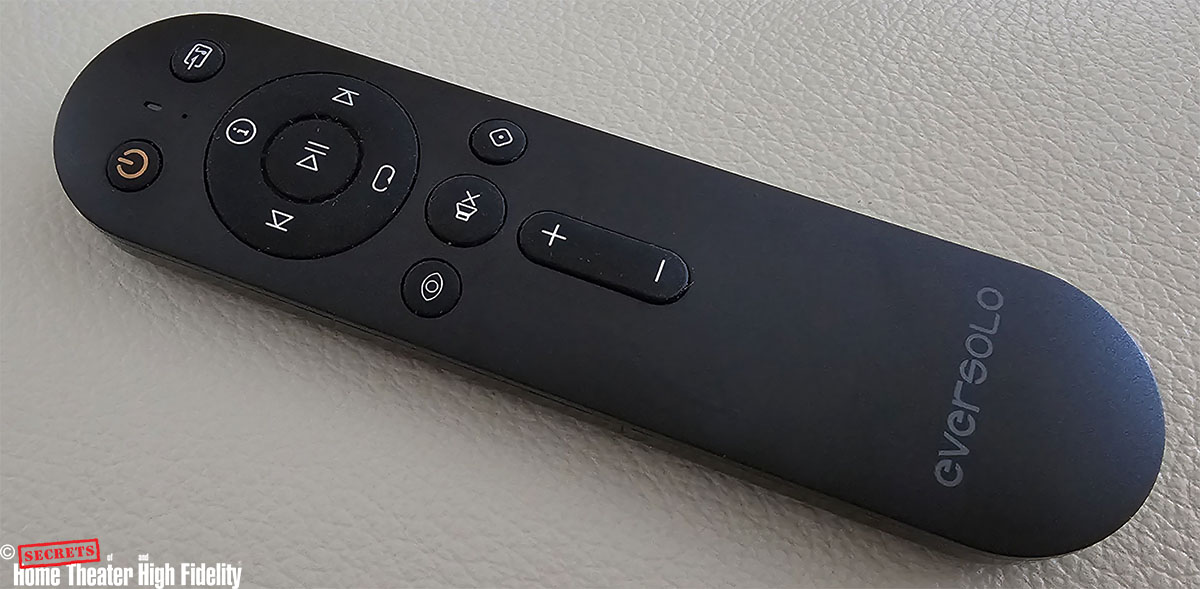 Eversolo DMP-A8 remote control
Eversolo DMP-A8 remote control
As mentioned, another way of controlling the DMP-A8 is through the Eversolo app, which is available in iOS or Android versions. This is my preferred way of controlling the device during the review. In my opinion, the app has a nice interface and is quite intuitive to use. The app does not only provide basic playback control of the unit, but also provides access to system settings and music libraries, either from streaming services or from local NAS, making it the one-stop hub for the operation of the device.
Setting up the DMP-A8 is relatively easy. Since its placement was not close to my modem/router, I connected the DMP-A8 to my home network using Wi-Fi. With such a connection, I did not get the Wake-on-LAN feature as with a wired network connection. Turning on the device using the remote control was not too big a deal for me, since I usually only turned it on when I was in the room and ready to listen. If you, however, like the multi-room convenience, where turning on the device from another room is a must-have capability, then you would need to somehow manage to connect a wired LAN to the DMP-A8. The setting up of the network connection using the device’s front touchscreen display was quite a breeze. Once this network connection had been established, I could find the device in the Eversolo app and perform the rest of the setup there.
As the DMP-A8 is a multi-function device, I tested it as part of various system configurations with a Krell KAV-2250 amplifier and Revel Ultima Studio speakers as the downstream components. Upstream and other components used depend on the DMP-A8 function tested. These include the Classe CP-700 preamplifier, PS Audio DirectStream DAC, and Auralic Aries G1 streamer.
With a multi-function device like the DMP-A8, I would not be surprised if it exhibited a wide range of performance variations in performing its functions. However, to my amazement, the DMP-A8 did not show any glaring hole in its performance as it functions as a streamer, a preamplifier, or a DAC. I found its performance consistency across its functions to be nothing short of admirable. As such, the DMP-A8 possesses the right traits to be used as the centerpiece of a high-fidelity music system.
As a DAC, the DMP-A8 was not only state-of-the-art in terms of its capability of processing high-resolution digital signals up to DSD512 Native and 32-bit/768-kHz PCM, but it also delivered respectable performance. Its DAC processing excelled in resolving details and deciphered sonic nuances in the recording. Overall, the DMP-A8 sounded sufficiently balanced across the audible frequency spectrum and conveyed music with great transparency. Moreover, the DMP-A8 offers five options of DAC filters (sharp roll-off, slow roll-off, short delay sharp roll-off, short delay slow roll-off, and super-sharp roll-off), the selection of which could result in subtle yet differentiable sonic outcomes. The default was the short delay sharp roll-off filter, which I found to be where I settled my filter choice after trying out the others. I thought this filter gave me the best balance between sonic smoothness and neutrality. I should note that with the associated equipment used in this review, regardless of the filter used, the resulting sonic characteristics hovered pretty much around the neutral region in the bright to warm scales. If your sonic taste is toward the warm side of neutral, then you will need to pair the DMP-A8 with warmer-sounding components downstream.
Used in conjunction with its internal streamer, the DMP-A8 became a potent streaming DAC device. I spent a good chunk of time evaluating the DMP-A8 in its streaming DAC function in this review (connected to Classe CP-700 preamplifier and Krell KAV-2250 amplifier) and came away impressed. In such a function, it was hard to think of other components out there that bested the DMP-A8 in features and performance in the sub-$2,000 price range. The streaming control using the Eversolo app was a delight to use, and the device responded swiftly to the selected playback track through the app. Besides displaying the album cover figure and the track information on the device’s front screen, this information was also displayed in the app, hence eliminating the need for reading the small text on the front display.
 Dress’ How Deep Is Your Love (2024) album cover
Dress’ How Deep Is Your Love (2024) album cover
Dress, “How Deep Is Your Love”
I streamed various types of music from Qobuz through the DMP-A8 and was generally satisfied with the outcome. The rendition of the track I Love You by a Korean R&B artist Dress (featuring Junny and Sam Ock) from his album How Deep Is Your Love (2024) exemplified the DMP-A8’s ability to present details and to convey a realistic sense of space. At the beginning of the track, the singer is portrayed deep in the soundstage as it should be with sufficient focus. And later on, the singer was depicted to be at the center of the stage surrounded by layers of musical instruments. This soundstage positional change was succinctly portrayed by the DMP A8. The DMP-A8 also did a good job of depicting the separation among the various instruments on the stage. It was not the most three-dimensional soundstage that I had heard from this track, but nevertheless, the focus and soundstage presentation of the DMP-A8 were realistic.
 Diana Krall’s Wallflower (2014) album cover
Diana Krall’s Wallflower (2014) album cover
Diana Krall, “Wallflower”
The DMP-A8 felt right at home on music with strong vocal content. Diana Krall’s voice in the track Sorry Seems to Be the Hardest Word from Diana Krall’s Wallflower album (2014) sounded natural and full-bodied streamed through the DMP-A8. Even her breathing and sibilance were conveyed realistically. The spatial cues in the track were rendered beautifully as well, projecting a musical stage in an intimate setting. The DMP-A8 did a good job overall in imparting a sense of flow in the music, which allowed my emotions to ride along with it.
 Keiko Matsui’s Journey To The Heart (2016) album cover
Keiko Matsui’s Journey To The Heart (2016) album cover
Keiko Matsui, “Journey To The Heart”
The DMP-A8 was no slouch either in conveying rhythm as well as preserving textural content in the recording. Keiko Matsui’s Journey To The Heart (2016) album exemplified the adeptness of the DMP-A8 in conveying the rhythm and pace of the music. Listening to some fast-paced and rhythmical jazzy bossa-nova tracks in there through the DMP-A8, such as Havana Night and Casablanca, had me toe-tapping and swaying with the music. Besides the nice soundstage portrayal, the presentation of the texture in the music was respectable. Given a good recording, the DMP-A8 had the knack of never letting the music sound flat or dull.
For comparison, I connected the DMP-A8’s coaxial digital output to the PS Audio DirectStream DAC before the connection to the preamplifier. The DirectStream DAC carried a $6,000 price tag, which was more than three times the price of the DMP-A8. Hence, no surprise that it was generally better than the DMP-A8 as a DAC. However, the difference was not night and day, and overall, the DMP-A8 held its ground extremely well in this unfair comparison. The clarity, dynamics, and details of the sonic results were pretty much equivalent, and it only succumbed to the DirectStream DAC in the fullness, depth, and three-dimensionality of the sonic presentation.
To my delight, the DMP-A8 was quite adept in functioning as an analog preamplifier. Its R2R volume control and fully balanced preamplifier circuit design maintained the integrity of the analog input signals well without adding audible spurious noise or reducing the transparency of the presentation. The sound of clicking relays when changing the volume level could be heard at the listening position and it might take time to get used to, but after a while I found myself not even slightly bothered by it. As a preamplifier, the DMP-A8 was sufficiently neutral in the sense that it performed its duty without imparting its sound. It might not convey the sense of space and sonic palpability as well as the Classe CP-700 that I utilized in this review, but then again, they were not remotely in a similar price category. But the fact that Eversolo could pack a respectable preamplification function as part of a sub-$2,000 multi-function device like this was a remarkable engineering feat. For those of you considering removing a separate preamplifier from the setup and just using the DMP-A8 to drive a power amplifier directly, you are in luck here as the DMP-A8 is definitely up to the task to handle such a setup.
Secrets Sponsor
The Eversolo DMP-A8 sets a new bar for an integrated streamer-DAC-preamplifier with its excellent versatility, features, and performance that exceeds its price of admission.
- Excellent build quality with an attractively simple appearance.
- Versatile wired and wireless input-output connectivity.
- Excellent DAC with high-resolution PCM and DSD processing capability.
- Full operational control using the Eversolo app.
- SSD storage expansion feature.
- Solid sonic performance.
The Eversolo DMP-A8 is as competent a streamer-DAC-DAP-preamplifier as you can likely find in the sub-$2,000 price category. Not only does it boast excellent build quality and full features for each of its functions, but it also exhibits prowess in performing all the tasks within its capabilities. More importantly, the sonic performance of the DMP-A8 is superior to many of its competitors and can even compete confidently with the higher-priced components out there. Considering all these factors, the DMP-A8 indeed brings in a lot of value for money. The DMP-A8 is the very definition of a product with a high performance-to-price ratio that easily earns my strong recommendation.


